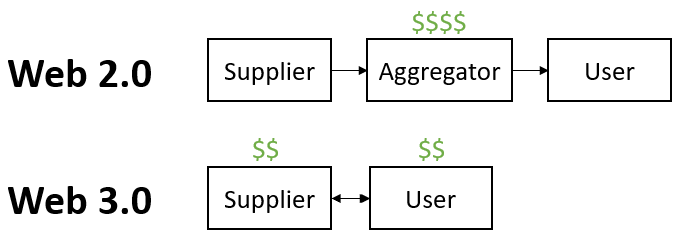Why Decentralisation Matters
Why decentralisation is a misunderstood concept and how it can affect the future of the internet.
In 2018, A16Z’s Chris Dixon wrote a great piece on why decentralisation matters and how it can affect the future of the internet. In this newsletter, I revisit his main points.
Web 1.0 vs Web 2.0
We have seen two substantially different versions of the internet since its inception in the 1980s:
Web 1.0 (the 1980s-2000s) - The Internet is built on open protocols controlled by the internet community.
Web 2.0 (mid-2000s-current) - For-profit tech companies built software and services that rapidly outpaced the capabilities of open protocols. This led to aggregators getting increasingly more control over the internet through centralisation. See yesterday’s newsletter “Is Disruption Dead?”.
One response to centralisation is regulation, which assumes that the internet is similar to past communication networks like phone networks and TV networks. However, those were hardware-based networks and the internet is a software-based network.
Software-based networks, unlike hardware-based networks, can be rearchitected through innovation. The internet is still early in its evolution and most likely it will be entirely rearchitected in the coming decades.
Decentralisation - A Misunderstood Concept
Decentralisation is a misunderstood concept. Often it’s believed that decentralisation is favoured to resist government censorship, or because of libertarian political views. These are not the main reasons for decentralisation.
Centralised platforms start by recruiting users and 3rd parties by providing maximal value. However, as these platforms are adopted, their power over users and 3rd parties also grow. Ultimately, a positive-sum relationship turns into a zero-sum relationship.
This is because the easiest (only?) way to keep growing is to extract data from users and compete with 3rd parties over audiences and profits, ultimately taking over the entire market (see: aggregators).
The Perk of Decentralisation
Decentralised crypto networks align network participants to work together toward a common goal by using consensus mechanisms to maintain and update state, and incentive mechanisms to validate the network. They are open-source and are kept in check by every participant having a voice on the platform.
The goal is the growth of the network and appreciation of the token, which builds a very robust network effect. Decentralised networks can win the third era of the internet the same way they won the first era: by winning the hearts and minds of entrepreneurs and developers.
To compare centralized and decentralised systems you need to consider them as dynamic processes, not static products. Centralized systems often start fully baked with compelling use cases. In contrast, decentralised platforms often launch half-baked without clear use cases.
They need to go through two phases of product-market fit: The first phase is between the platform and the developers who build out the ecosystem, and the second phase is between the ecosystem and the end-users. This two-stage process is why decentralised platforms’ potential is consistently underestimated.
However, under the right conditions, they can grow exponentially as they attract new contributors. They are a powerful way to develop community-owned networks and level the playing field for everyone (3rd-party developers, creators, and businesses).
We saw the value of decentralisation in Web 1.0, but centralised platforms have been dominant for so long that many people have forgotten the perks of decentralisation.
Hopefully, we’ll get to see it again in the next internet era.
Chris Dixon’s memo from 2018:
Did you enjoy this newsletter? Please subscribe if you haven’t already!





